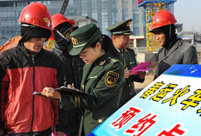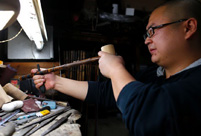 'Jin' named the word of the year by cross-strait netizens
'Jin' named the word of the year by cross-strait netizens Chinese scientific expedition goes to build new Antarctica station
Chinese scientific expedition goes to build new Antarctica station
 Chinese naval escort fleet conducts replenishment in Indian Ocean
Chinese naval escort fleet conducts replenishment in Indian Ocean 17th joint patrol of Mekong River to start
17th joint patrol of Mekong River to start China's moon rover, lander photograph each other
China's moon rover, lander photograph each other Teaming up against polluters
Teaming up against polluters
The Chinese mainland’s first outbreak of H5N2 bird flu, which killed 4,000 birds at a chicken farm, is under control, authorities in a northern province said yesterday.
The chickens died at the Hufeng farm in Baoding City in Hebei Province last Tuesday, the local government said.
A total of 125,700 chickens were culled on Thursday and safely disposed of and surrounding areas have been sterilized, it said. Areas within 3 kilometers of the farm have been cordoned off.
Eleven people found to have been in contact with the poultry have been isolated but none has been confirmed as infected with the virus, officials said.
On Thursday night, more than 1,000 paramilitary and police officers were sent to the farm to cull the birds. On Saturday, the state lab for bird flu confirmed it was the H5N2 strain that had caused the initial deaths.
The privately run Hufeng chicken farm was established in 1992. The chickens that had died from the H5N2 virus were bought in late November.
The outbreak was the first of its kind on the Chinese mainland. Taiwan reported infections of H5N2 in chickens in March 2012, triggering a cull of 58,000 poultry.
In other bird flu cases, Jiangxi Province in east China confirmed a human case of the H10N8 strain last Wednesday.
And earlier last week, four new human cases of H7N9 bird flu were confirmed in south China’s Guangdong Province.
China reported the world’s first human case of H7N9 bird flu infection in March.
As of Friday, a total of 136 people have been confirmed as infected with the virus, the National Health and Family Planning Commission said.
Of those infected, 45 had died, representing a fatality rate of 33.1 percent. No cases have been reported in other countries so far.
China had relied on imported vaccines for H7N9 but on October 26 Chinese researchers said they had developed their own.
Shu Yuelong, director of the Chinese National Influenza Center, said it was the first influenza vaccine to have been developed by Chinese scientists.
Shu, also director of the WHO Collaborating Center for Reference and Research on Influenza, said the vaccine had provided important technical support in the fight against the flu strain, making a contribution to the H7N9 flu virus epidemic control all over the world.
However, Zhong Nanshan, a renowned respiratory disease expert, said now is not a good time to produce the vaccine in large quantities as only sporadic cases had been reported in the nation, China News Service reported yesterday. Zhong, an outspoken medical scientist, is widely respected for his role in China’s fight against the SARS epidemic.
But he warned health authorities in the Pearl River Delta, which includes Guangdong Province, to be cautious.
Since August, Guangdong has reported six cases. The youngest is just 3 years old and the oldest is 65. The condition of two patients, one in Shenzhen and one in Yangjiang, had deteriorated, Zhong told a press conference yesterday.
Guangdong is fully prepared, he said, with 140,000 boxes of Tamiflu — the leading pharmaceutical weapon against flu and sterilization and prevention equipment valued at 6 million yuan (US$988,200) in storage.
Zhong didn’t exclude the possibility of human to human transmission, but said the effect was very limited. “We have studied 150 cases so far and found two cases involving human transmission. But they were family members and had intimate contact,” Zhong said.
If medical professionals predict an H7N9 outbreak or confirm human to human transmission, then China will be able to produce vaccines in large numbers, Zhong told reporters.
 People prepare for upcoming 'Chunyun'
People prepare for upcoming 'Chunyun'  Highlights of Beijing int'l luxury show
Highlights of Beijing int'l luxury show Record of Chinese expressions in 2013
Record of Chinese expressions in 2013 China's moon rover, lander photograph each other
China's moon rover, lander photograph each other 17th joint patrol of Mekong River to start
17th joint patrol of Mekong River to start Spring City Kunming witnesses snowfall
Spring City Kunming witnesses snowfall Heritage of Jinghu, arts of strings
Heritage of Jinghu, arts of strings Weekly Sports Photos
Weekly Sports Photos PLA elite units unveiled
PLA elite units unveiled  China's stealth fighters hold drill over plateau
China's stealth fighters hold drill over plateau Chinese navy hospital ship's mission
Chinese navy hospital ship's mission  "Free lunch" program initiated in NW China
"Free lunch" program initiated in NW China  Rime scenery in Mount Huangshan
Rime scenery in Mount Huangshan DPRK's Kaesong Industrial Complex
DPRK's Kaesong Industrial Complex 'Jin' named the word of the year
'Jin' named the word of the year Day|Week|Month